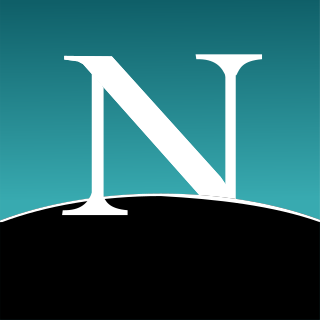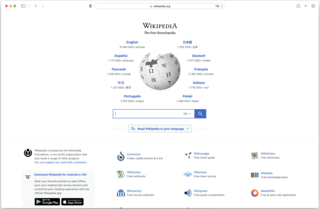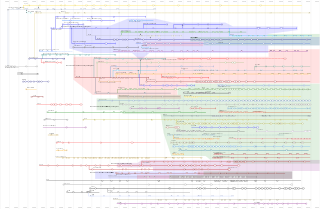
Internet Explorer is a retired series of graphical web browsers developed by Microsoft that were used in the Windows line of operating systems. While IE has been discontinued on most Windows editions, it remains supported on certain editions of Windows, such as Windows 10 LTSB/LTSC. Starting in 1995, it was first released as part of the add-on package Plus! for Windows 95 that year. Later versions were available as free downloads or in-service packs and included in the original equipment manufacturer (OEM) service releases of Windows 95 and later versions of Windows. Microsoft spent over US$100 million per year on Internet Explorer in the late 1990s, with over 1,000 people involved in the project by 1999. New feature development for the browser was discontinued in 2016 and ended support on June 15, 2022 for Windows 10 Semi-Annual Channel (SAC), in favor of its successor, Microsoft Edge.

Netscape Navigator is a discontinued proprietary web browser, and the original browser of the Netscape line, from versions 1 to 4.08, and 9.x. It was the flagship product of the Netscape Communications Corp and was the dominant web browser in terms of usage share in the 1990s, but by around 2003 its user base had all but disappeared. This was partly because the Netscape Corporation did not sustain Netscape Navigator's technical innovation in the late 1990s.
Netscape Communications Corporation was an American independent computer services company with headquarters in Mountain View, California, and then Dulles, Virginia. Its Netscape web browser was once dominant but lost to Internet Explorer and other competitors in the so-called first browser war, with its market share falling from more than 90 percent in the mid-1990s to less than one percent in 2006. An early Netscape employee Brendan Eich created the JavaScript programming language, the most widely used language for client-side scripting of web pages and a founding engineer of Netscape Lou Montulli created HTTP cookies. The company also developed SSL which was used for securing online communications before its successor TLS took over.

A web browser is an application for accessing websites and the Internet. When a user requests a web page from a particular website, the browser retrieves its files from a web server and then displays the page on the user's screen. Browsers are used on a range of devices, including desktops, laptops, tablets, and smartphones. In 2020, an estimated 4.9 billion people have used a browser. The most used browser is Google Chrome, with a 65% global market share on all devices, followed by Safari with 18%.

Cello is an early, discontinued graphical web browser for Windows 3.1; it was developed by Thomas R. Bruce of the Legal Information Institute at Cornell Law School. It was released as shareware in 1993. While other browsers ran on various Unix machines, Cello was the first web browser for Microsoft Windows, using the winsock system to access the Internet. In addition to the basic Windows, Cello worked on Windows NT 3.5 and with small modifications on OS/2.

Marc Lowell Andreessen is an American businessman and software engineer. He is the co-author of Mosaic, the first widely used web browser with a graphical user interface; co-founder of Netscape; and co-founder and general partner of Silicon Valley venture capital firm Andreessen Horowitz. He co-founded and later sold the software company Opsware to Hewlett-Packard. Andreessen is also a co-founder of Ning, a company that provides a platform for social networking websites and an inductee in the World Wide Web Hall of Fame. Andreessen's net-worth is estimated at $1.7 billion.

A browser war is a competition for dominance in the usage share of web browsers. The "first browser war," (1995–2001) pitted Microsoft's Internet Explorer against Netscape's Navigator. Browser wars continued with the decline of Internet Explorer's market share and the popularity of other browsers including Firefox, Google Chrome, Safari, Microsoft Edge and Opera.
Spyglass, Inc. was an Internet software company. It was founded in 1990, in Champaign, Illinois, as an offshoot of the University of Illinois at Urbana–Champaign, and later moved to Naperville, Illinois. Spyglass was created to commercialize and support technologies from the National Center for Supercomputing Applications (NCSA). It focused on data visualization tools, such as graphing packages and 3D rendering engines.

SlipKnot was one of the earliest World Wide Web browsers, available to Microsoft Windows users between November 1994 and January 1998. It was created by Peter Brooks of MicroMind, Inc. to provide a fully graphical view of the web for users without a SLIP or other TCP/IP connection to the net, hence the name – SLIP...not. SlipKnot provided a graphical web experience through what would otherwise be a text-only Unix shell account. SlipKnot version 1.0 was released on November 22, 1994, approximately 3 weeks before Netscape's Netscape Navigator version 1.0 came out. It was designed to serve a significant fraction of PC/Windows-based Internet users who could not use Mosaic or Netscape at that time.

Microsoft developed 11 versions of Internet Explorer for Windows from 1995 to 2013. Microsoft also developed Internet Explorer for Mac, Internet Explorer for UNIX, and Internet Explorer Mobile respectively for Apple Macintosh, Unix, and mobile devices; the first two are discontinued but the latter runs on Windows CE, Windows Mobile, and Windows Phone.

Microsoft Internet Explorer 3 (IE3) is the third, and by now, discontinued, version of the Internet Explorer graphical web browser which was announced in March 1996, and was released on August 13, 1996 by Microsoft for Microsoft Windows and on January 8, 1997 for Apple Mac OS. It began serious competition against Netscape Navigator in the first Browser war. It was Microsoft's first browser release with a major internal development component. It was the first more widely used version of Internet Explorer, although it did not surpass Netscape or become the browser with the most market share. During its tenure, IE market share went from roughly 3–9% in early 1996 to 20–30% by the end of 1997. In September 1997 it was superseded by Microsoft Internet Explorer 4.
Eric J. Bina is an American software programmer who is the co-creator of Mosaic and the co-founder of Netscape. In 1993, Bina along with Marc Andreessen authored the first version of Mosaic while working as a programmer at National Center for Supercomputing Applications (NCSA) at the University of Illinois at Urbana-Champaign.

A throbber, also known as a loading icon, is an animated graphical control element used to show that a computer program is performing an action in the background. In contrast to a progress bar, a throbber does not indicate how much of the action has been completed.

The World Wide Web is a global information medium which users can access via computers connected to the Internet. The term is often mistakenly used as a synonym for the Internet, but the Web is a service that operates over the Internet, just as email and Usenet do. The history of the Internet and the history of hypertext date back significantly further than that of the World Wide Web.
In the context of the World Wide Web, a bookmark is a Uniform Resource Identifier (URI) that is stored for later retrieval in any of various storage formats. All modern web browsers include bookmark features. Bookmarks are called favorites or Internet shortcuts in Internet Explorer and Microsoft Edge, and by virtue of that browser's large market share, these terms have been synonymous with bookmark since the First Browser War. Bookmarks are normally accessed through a menu in the user's web browser, and folders are commonly used for organization. In addition to bookmarking methods within most browsers, many external applications offer bookmarks management.

The Netscape web browser is the general name for a series of web browsers formerly produced by Netscape Communications Corporation, which eventually became a subsidiary of AOL. The original browser was once the dominant browser in terms of usage share, but as a result of the first browser war, it lost virtually all of its share to Internet Explorer due to Microsoft's anti-competitive bundling of Internet Explorer with Windows.
A web desktop or webtop is a desktop environment embedded in a web browser or similar client application. A webtop integrates web applications, web services, client–server applications, application servers, and applications on the local client into a desktop environment using the desktop metaphor. Web desktops provide an environment similar to that of Windows, Mac, or a graphical user interface on Unix and Linux systems. It is a virtual desktop running in a web browser. In a webtop the applications, data, files, configuration, settings, and access privileges reside remotely over the network. Much of the computing takes place remotely. The browser is primarily used for display and input purposes.
Jon E. Mittelhauser is a software executive who co-wrote the Windows version of NCSA Mosaic and was a founder of Netscape.
A web browser is a software application for retrieving, presenting and traversing information resources on the World Wide Web. It further provides for the capture or input of information which may be returned to the presenting system, then stored or processed as necessary. The method of accessing a particular page or content is achieved by entering its address, known as a Uniform Resource Identifier or URI. This may be a web page, image, video, or other piece of content. Hyperlinks present in resources enable users easily to navigate their browsers to related resources. A web browser can also be defined as an application software or program designed to enable users to access, retrieve and view documents and other resources on the Internet.












